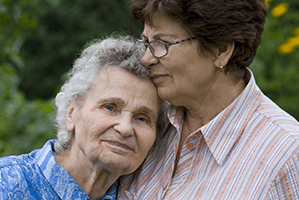
November is National Family Caregivers Month, a time to recognize those who care for family, friends, and neighbors, including the elderly, sick and disabled. While the elderly are healthier now than in previous generations, about 17 percent of Americans 65 and older need assistance with one or more daily activities, such as bathing or dressing (Himes, 2002); many more need assistance with chores, errands or transportation. Family members in the community provide most of this assistance; for example, 26 percent of adult daughters and 15 percent of adult sons report spending at least 100 hours/year caring for or helping their older parents (Johnson & Lo Sasso, 2000).
While important, these numbers obscure the many ways in which we are each embedded in networks of care. Some of us are directly involved in hands-on caregiving, but care also encompasses “caring about” – paying attention in such a  way that one sees and recognizes the need for care – and “caring for” – responding to other’s needs by taking responsibility for initiating caring activities (Fisher & Tronto, 1990).
way that one sees and recognizes the need for care – and “caring for” – responding to other’s needs by taking responsibility for initiating caring activities (Fisher & Tronto, 1990).
I think of my 88-year-old mother, living independently, even though she is vision-impaired and cannot drive. Her children, who do not live nearby, call her regularly, provide financial support and make sure her bills are paid, and take responsibility for ensuring that she receives the care she needs. When they do visit, she has a list of chores ready for them. Her friends provide rides to church and occasional lunches out. Her neighbor calls her daily, takes her food shopping and to doctors’ appointments. Another neighbor brings her books on tape, and helps her figure out the technology to listen to the audiobooks. But my mother is not just a receiver of care. She calls friends who need to talk, makes sure that someone is checking on others living alone, provides advice and labor for activities at church, as well as advice to her children, neighbors and friends. In her younger days, she was the one providing transportation to others, visiting people in the hospital or at home, or providing housing and financial support for her adult children.
These networks of care are often invisible, but they are essential to our communities. As our population ages, and those who provide care are increasingly employed outside of the home, caregiving demands are potentially in direct conflict with employment responsibilities. This reality demands recognition of caregivers not just this month, but year-round, by employers who can provide workplace flexibility – to accompany someone to doctors’ visits, provide transportation, or help with food shopping – and paid family and medical leave for intensive caregiving when needed.
Nancy Marshall, Ed.D., is an Associate Director and Senior Research Scientist at the Wellesley Centers for Women at Wellesley College. She leads the Work, Families & Children team at the Centers. For more than 20 years, researchers on the Work, Families and Children team have studied the lives of children and adults, and the workplaces, early care and education programs and families in which they live, work and grow. The Team applies an ecological systems model to the study of the lives of children and adults. From this perspective, individual lives are best understood in the context of social institutions, such as families, the workplace, and early care and education settings.
When you subscribe to the blog, we will send you an e-mail when there are new updates on the site so you wouldn't miss them.
Comments 1
Nancy,
This is a lovely post and a good reminder to all of us that there are more ways to help care for those we care about than simply being there physically. Sometimes an "old fashioned" phone call is the very best thing!
Susan